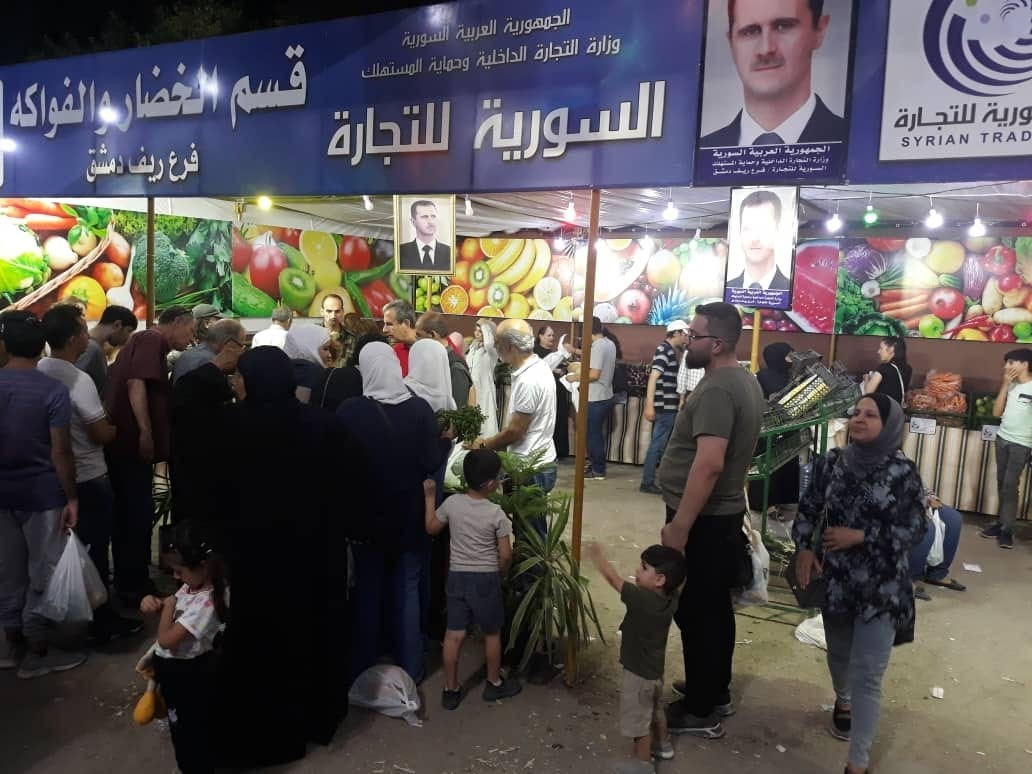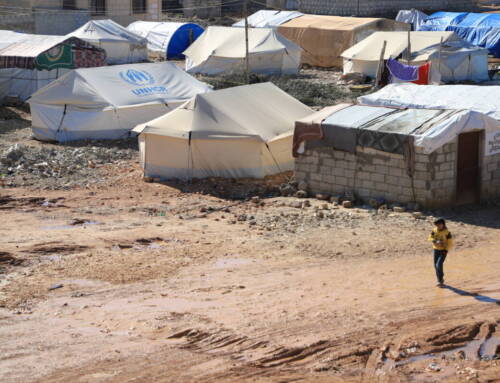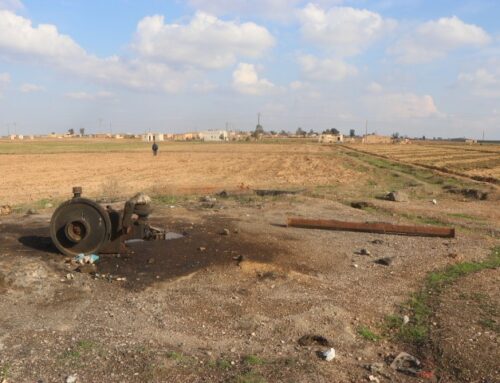‘Worst since the beginning of the 20th century’: What does 2024 hold for Syria’s economy in freefall?
In 2023, the Syrian pound fell to an unprecedented low, with living conditions in the country at their “worst since the beginning of the 20th century.” Will 2024 bring any relief, or only more of the same?
28 December 2023
PARIS — With the end of each year since 2011, Syrians have ushered in the new year with dreams of better days to come, only to find themselves facing new crises—especially with the country’s faltering economy. In 2023, the Syrian pound recorded an unprecedented decline, in its worst year to date. Will 2024 bring any relief, or only more of the same?
Each of Syria’s four areas of influence—territories held by the Autonomous Administration of North and East Syria (AANES), the Hayat Tahrir al-Sham (HTS)-backed Syrian Salvation Government, the opposition Syrian Interim Government (SIG) and the regime—faces worsening living and economic conditions. But the reality in regime-held territories, the majority of the country, is the most dire.
As Damascus attempts to consolidate its influence and survival without meaningful economic reforms or policies to improve standards of living, Syrian citizens face increased costs. In 2023, Damascus lifted subsidies on fuel and other basic goods, and moved towards legitimizing the amperes electricity system. Many citizens have lost hope and, unable to meet their basic needs, left the country. The past year brought a new wave of emigration from regime areas.
Currency not worth the cost of printing
By the end of 2023, the value of the Syrian pound had deteriorated to an unprecedented level. The exchange rate on the black market stood at SYP 14,000 to the dollar, compared to SYP 6,180 to the dollar in December 2022, and SYP 3,620 to the dollar in December 2021.
By December 2023, the Syrian pound had lost approximately 130 percent of its value compared to the start of the year. In 2022, it lost 70 percent of its value, compared with a 24 percent loss in 2021.
Overall, the pound has lost 99.64 of its value against the dollar compared to where it stood before 2011, Manaf Quman, economics researcher at the Turkey-headquartered Omran Center for Studies, said. “The value of Syrian currency has become less than it costs to print it,” he added, considering “the cost to print a banknote ranges between five and 15 cents, including the price of paper, ink, design, printing, security features, etcetera.”
Karam Shaar, director of the Syria Program at the Observatory of Political and Economic Networks, attributed the ongoing collapse of the Syrian pound to what he described as “the Syrian government’s inability to stimulate the economy in a way that would attract foreign currency,” which he viewed as “the root of the problem.”
Rather than carrying out economic reforms, the Damascus government has “covered inflation by printing more currency, which is itself an inflationary measure,” Shaar added. Damascus’ decision to double public sector salaries in August 2023 produced “an increase in the supply of the pound after pumping more quantities of it into the market, and therefore more inflation,” he told Syria Direct. “The last two years have seen the pound pumped in unprecedented numbers, compared to previous years.”
Central bank chases the black market
In mid-July, the Central Bank of Syria adjusted the exchange rate of the US dollar against the Syrian pound for the first time to approximate the black market rate. With that, the official exchange rate reached SYP 9,900 to the dollar, compared with SYP 11,5500 on the parallel market.
In the months that followed, the central bank began to constantly chase black market rates, until the official exchange rate reached SYP 12,500 in December, compared to SYP 14,000 in the parallel market.
The central bank’s policy indicates that it “does not possess hard currency, and is not able to cover demand in the markets for foreign currency,” Quman said. He called the move to approximate the black market rate “a tacit recognition by the central bank that it is devoid of hard currency.”
The central bank is also trying to “compete with the black market for foreign currency, by attracting remittances and hard currency transfers to the central bank’s channels,” Quman said. With this policy, “the central bank has changed its monetary policy from stabilization to partial floating.”
Shaar called the central bank’s approach to the black market exchange rates a “good policy,” allowing the regime to “drive many transfers and economic activities towards the official market, instead of the black market.” It also led to the unification of multiple central bank exchange rates under the “official market bulletin, after there had been a banks bulletin and an exchange bulletin, which simplified monetary procedures in Syria,” he added.
“The central bank is overloaded,” Shaar said, noting that “the main problem is economic management based on oligopoly, extortion, looting and theft,” which “reduces the chances of the economy improving as it should,” given that “the majority of those who are able to produce and integrate in the market and get the wheel of the economy turning again are apprehensive about entering the market for fear of their wealth being stolen, or regime extortion,” which negatively impacts “economic recovery.”
Accordingly, without real will and serious steps from those in power, the central bank’s efforts to stop the collapse of the Syrian pound cannot succeed, and it will continue to pursue black market exchange rates.
‘The worst since the beginning of the 20th century’
In late September, Syrian President Bashar al-Assad acknowledged, in an interview aired on China Central Television (CCTV), that conditions in Syria were poor, stating: “Let us be clear, it is a bad situation and suffering is increasing.” He blamed the West for continuing to “strangle” the Syrian people, referring to Western and United States sanctions on the Syrian regime and its key figures.
Regime recognition that Syria’s already poor economic situation was deteriorating was not new. Months before, Prime Minister Hussein Arnous described the country’s economy in similar terms. But the words were not accompanied by effective solutions to improve Syrians’ economic and living situations.
In June, United Nations Secretary-General Antonio Guterres said that nine out of every 10 Syrians live below the poverty level, noting that more than 15 million Syrians, or 70 percent of the total population, need humanitarian assistance.
By September, the average monthly cost of living for a Syrian family of five had jumped to SYP 9.5 million ($673), up from SYP 6.5 million ($460) two months earlier in July, according to the Kassioun newspaper’s economic index. The minimum cost of living also jumped, from SYP 4.1 million in July to SYP 5.9 million in September (from $290 to $418). Meanwhile, the minimum wage reached SYP 185 million ($13)—covering only two percent of the minimum monthly cost of living.
Shaar described Syria’s living situation as “the worst since the beginning of the 20th century,” for which he held the regime responsible “as a result of its continued encroachment on various economic activities to ensure its survival, in addition to other factors such as the decrease in humanitarian aid and decrease in private economic activities.”
“So long as the ingredients of the economic crisis are there, and the situation goes from bad to worse, prices will continue to rise continuously, and the pound to fall,” Quman said. “Living conditions are very bad, and this description is not new. It has been the case for several years, and the threshold of how bad things get cannot be determined.”
“A citizen lives most of the month on aid and money transfers from abroad, at a time when his salary is not enough to cover the costs of the first week of the month, which is one of the UN classifications of extreme poverty,” Quman noted.
Deteriorating living conditions and the regime raising the price of fuel, in mid-August, triggered popular protests in Daraa and Suwayda, in Syria’s south, alongside opposition voices in the Syrian coast, calling for Assad to fall. Demonstrations continue to this day in Suwayda.
What does 2024 hold?
At the start of December, the UN World Food Program (WFP) announced the end of its main food assistance program throughout Syria, effective January 2024, due to a lack of funding. The WFP said it would continue to support families impacted by emergencies and natural disasters throughout the country through “smaller, more targeted emergency interventions.”
Meanwhile, there appears to be no indication of economic conditions improving, “so long as the regime remains in power and manages the country’s economy,” Quman said. “The economy is linked to the lawmaker, the government, which manages resources and wealth.”
Any way out for Syria’s economy in 2024 is unlikely, Shaar said, without “a political solution that guarantees the return of capital, the activation of the economic cycle, and the start of reconstruction.”
Since “the regime rejects any political move that would lead to a political settlement resulting in the lifting of sanctions and return of capital, things will continue to take a turn for the worse,” he added.
**
This report was originally published in Arabic and translated into English by Mateo Nelson.







